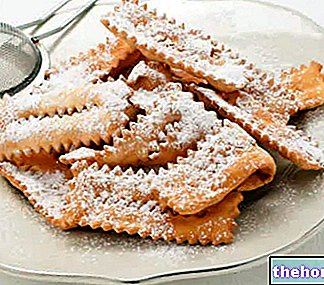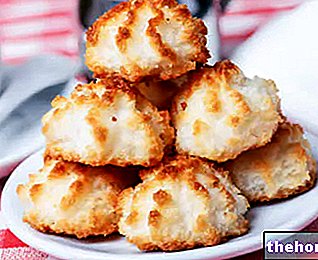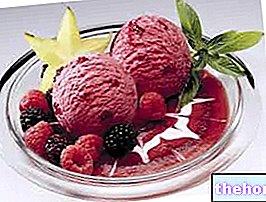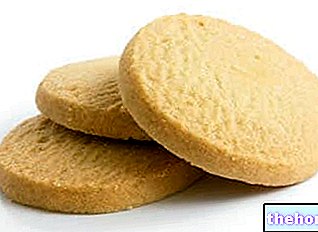Generality
PLEASE NOTE: although they are often confused, the mustard and the mustard sauce They do NOT represent the same preparation. This misunderstanding (now rooted in Italy) arises from the "use in both recipes of mustard seeds (whole, chopped or pounded, or pure essence); nevertheless, the two preparations are totally different both for flavor and for culinary use .

Mustard is a very caloric, very sugary and spicy food, which is born as a combination with boiled meat (beef muscle, osso buco, hen, capon, guinea fowl, tongue, etc.). It is consumed more frequently in the winter when both the boiled meat and the meat left over from the broth become customary weekly preparations (especially during the Christmas period).
Mustard is therefore a type of preserved fruit; some strongly resemble a jam, others candied fruit and then in syrup.
Mustard was mentioned for the first time by a French (nation of origin) who gave it the name of mustum ardens (post-classical Latin), since, at least initially, it seems that it was made up of cooked red wine must and added to chopped mustard (paradoxically very similar to the current Sicilian mustard*).
* The Sicilian mustard is a dessert quite particular that it has little to do with the typical "Po Valley" mustard.
Sicilian mustard is produced with fresh, unfermented must of regional red grapes (sweeter and less hydrated than the northern one); the juice is then filtered from the marc, boiled with a tightly closed bundle containing ash (obtained from untreated wood) and, towards the end of cooking, thickened with a little soft wheat flour. Having reached a consistency similar to a custard or a bechamel, the Sicilian mustard is filtered, portioned into saucers or bowls and, on the surface, sprinkled with chopped hazelnuts previously roasted in the oven (always available on the slopes of the volcano or on the surrounding hills) . The Sicilian mustard does NOT require sweetening with sucrose.
Preparation of the easy homemade mustard
According to the Cremonese, the preparation of "any mustard" is not particularly complex; on the other hand, to obtain the "right" mustard, the situation changes completely. Both a certain experience and the foresight to note one year for the other are decisive: the ingredients, the proportions of the fruit mixture and the quantity essence of mustard or crushed mustard. In this way, it is possible to work continuously and for a long time on one's own recipe, perfecting it over time. to the experts of the famous sauce; instead, let's limit ourselves to providing a basic and always welcome recipe of mustard:
Simple mustard ingredients: mixed fruit (cherries, pears, quinces, tangerines and / or seedless oranges, figs, apricots and peaches, and possibly exotic fruits such as pineapple, mango and papaya); water as required; sucrose or fructose (in an amount equal to half, by weight, of the cut fruit); mustard in grains (about 25%) or mustard essence (10 to 20 drops per 1000g).
Process for the production of simple mustard
- peel the tangerines and / or oranges, figs (green only), pineapple, mango and papaya (according to taste, also prepare apricots, peaches, pears and quinces);
- pit cherries, apricots and peaches (and possibly mango and papaya);
- remove the core from pears, quinces and pineapples;
- cut the large fruit into pieces of about 20-40g;
- leave the fruit to macerate in sugar for a whole day (keeping it well covered and cool);
- put everything, with a little water, in a saucepan;
- over medium heat (and spread the flame), bring to a boil and cook for a few minutes without a lid (for fruit in pieces, always less than 10 minutes);
- leave to cool and rest for a day without a lid but covering with a cloth;
- repeat steps 5 - 8 once or twice (depending on the size of the fruit); then add the mustard essence or the crushed mustard grains in variable quantities;
- jar, sterilize and store in the pantry.
Hypothetical nutritional properties of mustard
The nutritional properties of mustard are therefore ambiguous; certainly, being preserved fruit, the mustard will be almost totally deprived of the thermo-labile vitamin supply and sensitive to oxidation (eg ascorbic acid or vitamin C), typical of the fresh fruit; furthermore, citing that preserved in syrup (Cremonese type), the saline content should also be significantly compromised by dilution in the preserving liquid. Looking at the ingredients, it is not difficult to understand how much mustard can negatively affect the nutritional balance of the meal; the intake of simple sugars (fructose and sucrose) is very high and with it also drastically increases the energy density of the preparation (in addition to the risk of dental caries). Mustard is therefore a food not recommended for both diabetic and diet of the overweight subject.
Let's be clear, mustard is a real "accompanying sauce" and the portions MUST adapt to this function; nevertheless, for the types of mustard "made from whole fruit or in large pieces", it is particularly difficult to respect the method of consumption. To limit the nutritional imbalance imposed by large portions of mustard it is advisable NOT to take other foods containing simple carbohydrates (and, in my opinion, not even those with complex carbohydrates) within the same meal.
The only positive aspect of mustard (besides the taste, of course!) Concerns the preparations that contain quince or quince pears; these fruits, in addition to giving an exceptional aroma, are very rich in dietary fiber (5.9g per 100g part This means that even small portions positively affect the achievement of the recommended daily allowance (about 30g per adult).
Other Foods - Fruits Apricots Sour cherries Cashews Pineapple Watermelon Orange Avocado Banana Persimmon Persimmons Apple Chestnuts Cedar Cherries Coconut Watermelon Dates Feijoa Fig of India Figs Strawberries Berries Passion fruit (Maracujà, Granadilla) Jujube Kiwi Raspberries Coconut milk Lemons Almond milk Mango Apples Quinces Pomegranate Melon Blackberries Mustard Medlar Olives Taggiasca Olives Fermented Papaya Pears Peaches Plantains (Cooking Bananas) Pomelo Grapefruit Pink Grapefruit Plums, prunes Fruit juices and fruit juices Grape juice Plums Grapes Sultanas and Raisins OTHER ITEMS FRUIT Categories Food Alcoholics Meat Cereals and derivatives Sweeteners Sweets Offal Fruit Dried fruit Milk and derivatives Legumes Oils and fats Fish and fishery products Salami Spices Vegetables Health recipes Appetizers Bread, Pizza and Brioche First courses Second courses Vegetables and Salads Sweets and Desserts Ice cream and sorbets Syrups, liqueurs and grappas Prepare Basic tions ---- In the kitchen with leftovers Carnival recipes Christmas recipes Light diet recipes Women's, mom's and dad's day recipes Functional recipes International recipes Easter recipes Gluten-free recipes Diabetic recipes Holiday recipes Valentine's Day recipes Vegetarians Protein recipes Regional recipes Vegan recipes




























